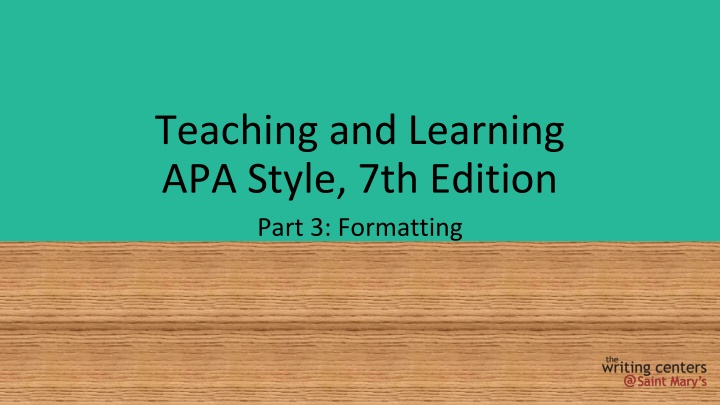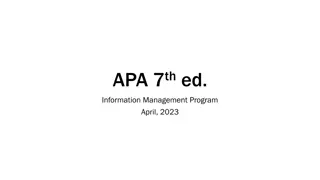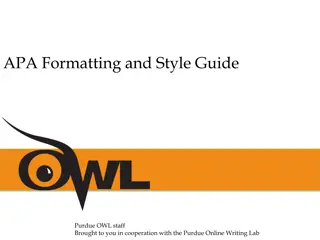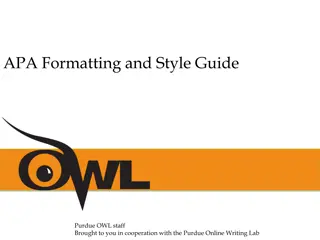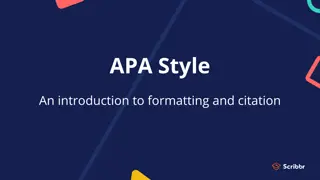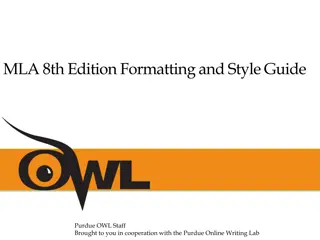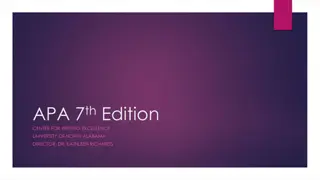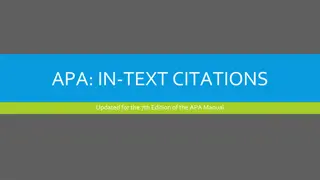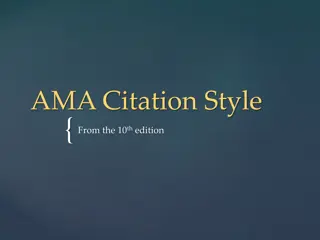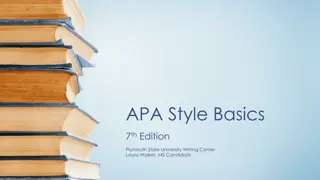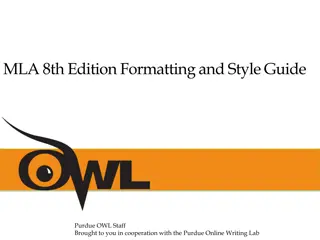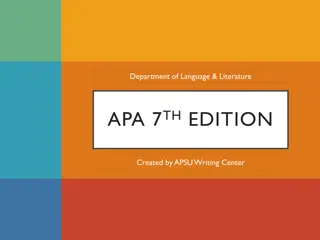APA Style 7th Edition Formatting Guidelines
Learn the APA guidelines for document formatting including margins, spacing, font, headings, tables, figures, bulleted and numbered lists, verb tense, pronouns, and more. Gain insights on maintaining consistency, using appropriate spacing, and aligning content effectively within your APA style paper.
Uploaded on Mar 05, 2025 | 2 Views
Download Presentation

Please find below an Image/Link to download the presentation.
The content on the website is provided AS IS for your information and personal use only. It may not be sold, licensed, or shared on other websites without obtaining consent from the author.If you encounter any issues during the download, it is possible that the publisher has removed the file from their server.
You are allowed to download the files provided on this website for personal or commercial use, subject to the condition that they are used lawfully. All files are the property of their respective owners.
The content on the website is provided AS IS for your information and personal use only. It may not be sold, licensed, or shared on other websites without obtaining consent from the author.
E N D
Presentation Transcript
Teaching and Learning APA Style, 7th Edition Part 3: Formatting
Objectives Learn APA guidelines for document formatting: Margins, spacing, and font Headings Tables and Figures Bulleted and numbered lists Numbers Verb tense and pronouns Additional resources and Q&A
APA Formatting: Overview Double spacing throughout document (except tables and figures) 1 inch margins Left alignment (except title page and some headings Paragraphs are indented .5 inches Title page is page 1 The same font should be used throughout the text of the paper. APA Style suggests a variety of fonts, both sans serif and serif (see p. 44). At the Writing Center, we recommend Times New Roman 12 pt. Insert one space after punctuation marks at the end of a sentence; commas, colons, and semicolons; periods between parts of a reference entry; and periods following initials in names.
Sample Title Page No running head Title page is Page 1 Title of paper in bold font Extra space between title and name For another example, see p. 32 of the APA Manual
Lettered Lists Use a lettered list when doing so will improve clarity, or will help draw attention to the items Use commas or semicolons between the items We tested three groups: (a) low scorers, who scored fewer than 20 points; (b) moderate scorers, who scored between 20 and 50 points; and (c) high scorers, who scored more than 50 points. (APA, 2020, pp. 189-90)
Numbered Lists Use a numbered list to display complete sentences or paragraphs in a series (e.g., itemized conclusions, steps in a procedure) If the items are phrases, use a lettered or bulleted list. We addressed the following research questions: 1. What research methodologies are used to examine the effects of cultural competency training? 2. How are psychologists trained to be culturally competent? 3. How are training outcomes assessed? 4. What are the outcomes of cultural competency training? (APA, 2020, pp. 189-90)
Bulleted Lists Use bullets to identify items in a series without implying chronology or order of importance. Symbols includes small circles, squares, and dashes are acceptable. For items that are complete sentences, begin each sentence with a capital letter For items that are not full sentences, begin each item with a lowercase letter. See pp. 190-191 for examples.
Bulleted Lists, Continued There are several ways in which psychologists could apply social-media- driven methods to improve their work: Social psychologists could use these methods to improve research on emotional experiences. Community psychologists could use these methods to improve population assessment at the city level. Clinical psychologists could use these methods to improve assessment or treatment. (APA, 2020, p. 190)
Numbers With some exceptions, numbers 10 and above are expressed as numerals and numbers below 10 are expressed as words. Numerals are also used for the following: numbers that immediately precede a unit of measurement (e.g., a 5-mg dose) numbers that represent statistical or mathematical function, fractional or decimal quantities, percentages, ratios, and percentiles and quartiles (e.g.,3 times as many, more than 5%, the 5th percentile) numbers that represent time, dates, ages, scores and points on a scale, exact sums of money, and numerals as numerals (e.g., 5 days, 1 hr 34 min, the numeral 6 on a keyboard) numbers that denote a specific place in a numbered series and parts of books or tables (e.g., Grade 4, Chapter 1) (APA, 2020, pp. 178-81)
Numbers, Continued Use words to express the following: numbers zero through nine numbers that begin a sentence, title, or heading common fractions (e.g., one fourth of the class) universally accepted usage (e.g., Five Pillars of Islam) To form the plurals of numbers, add s or es without an apostrophe twos and sixes; the 1990s; 20s and 30s (APA, 2020, pp. 178-81)
Verb Tense Paper section Recommended tense Example Literature review (or whenever discussing other researchers work) Past Quinn (2020) presented Present perfect Since then, many investigators have used Method Past Participants completed a survey Description of procedure Present perfect Others have used similar approaches Reporting of results Past Results were insignificant Scores increased Hypotheses were supported Discussion of implications of results Present The results indicate Presentation of conclusions, limitations, future directions, and so forth Present We conclude Limitations of the study are Adapted from American Psychological Association (2020). Publication Manual of the American Psychological Association (7th ed.), p. 118.
Pronouns Use I when writing a paper by yourself ; only use the pronoun we if you have coauthors. Do not use we when referring to people in general. Incorrect: We strive to encourage a love of reading. Correct: Elementary school teachers strive to encourage a love of reading. Use the singular they to refer to a person for whom they is the preferred pronoun, or in situations were gender is unknown or irrelevant to the context. The variant themself is acceptable. Use who for human beings; use that or which for inanimate objects and nonhuman animals.
Additional Resources Student Workshops Faculty Webinar Series Intro to APA Handbook APA Templates APA Website and Style Blog (apastyle.apa.org) Contact write@smumn.edu! Questions?
